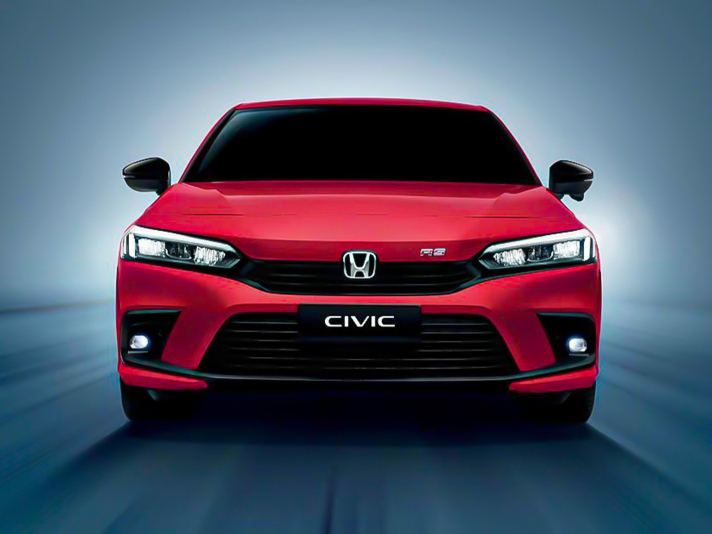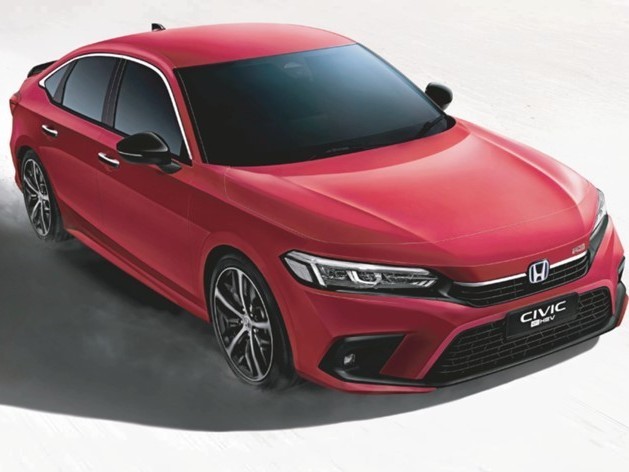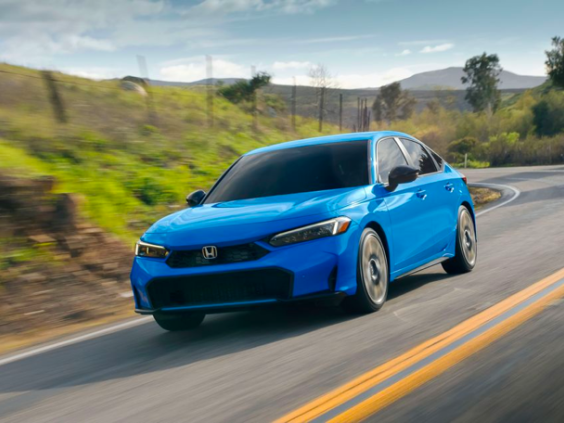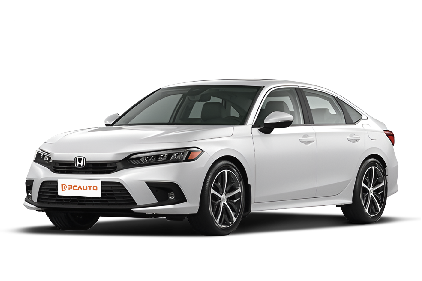Q
What Is the Length of Honda Civic?
The lengths of different versions of the Honda Civic vary slightly. Take the 2025 model as an example. The lengths of the Honda Civic 1.5L E, 1.5L V, 1.5L RS, and 2.0L e:HEV RS are all 4681mm. The lengths of previous older models, such as the 2023 and 2022 models, were 4678mm. The 2020 model was 4648mm long, and the 2018 model was 4630mm long. The length of a car affects the interior space layout. A longer body usually provides more spacious rear - seat and trunk space to meet the needs of passengers and cargo.
Special Disclaimer: This content is published by users and does not represent the views or position of PCauto.
Related Q&A
Q
What Segment Does Honda Civic Belong to?
The Honda Civic belongs to the C-Segment, which is in the compact car category. Compact cars typically have a body length ranging from 4.2 to 4.6 meters, focusing on being price - friendly, fuel - efficient, and convenient for daily use, with a design that balances practicality and driving pleasure.
The Honda Civic has a body length of about 4.6 meters. This size ensures ample interior space and handling flexibility. It offers a variety of power options, from naturally - aspirated to turbocharged engines, which can meet the needs of different consumers. The body design emphasizes aerodynamics and a modern look. With a young and stylish appearance, it's suitable for urban commuting and family trips. In the market, the Civic's direct competitors usually include other compact cars in the same class, such as the Toyota Corolla, Volkswagen Golf, Mazda 3, and Hyundai Elantra.
Q
What Is the Reslae Value of Honda Civic?
The Honda Civic maintains strong resale value in the used car market, consistently ranking among the best-retaining Japanese sedans in its class , particularly the newer tenth-generation (FC) and eleventh-generation (FK) models. Industry data shows Civic typically depreciates only 20%-30% over the first three years (depending on condition, mileage and market demand). For example, a 2020 Civic 1.5 TC originally priced around RM130k can still be priced at RM90k-RM100k in today's used market (varying by trim and maintenance history).
This exceptional value retention benefits from Honda's brand reputation, the appeal of its turbocharged engine (1.5L VTEC Turbo), and relatively low maintenance costs - though the base 1.8L naturally aspirated versions fetch slightly lower (yet still competitive) prices. Generally, low-mileage examples (under 15,000km annually) with complete service records and accident-free history are the most popular, while higher trims with Honda Sensing (like 1.5 TC-P) command premium resale prices over standard versions.
Additional factors affecting resale value include: preferred colors (white/gray being most popular), remaining factory warranty coverage, and aftermarket modifications (which may actually decrease value). Owners are advised to maintain regular authorized service center visits and keep complete documentation to maximize future resale potential.
Q
What's the Engine Displacement of Honda Civic?
The Honda Civic provides a variety of models with different displacements. The common displacements are 1.5L and 2.0L. When converted to CC (cubic centimeter, where 1L = 1000CC), they correspond to 1498CC and 1993CC respectively. The 1.5L models generally adopt the turbo - charged intake form, offering a fairly abundant power output, which can meet the needs of daily driving and some scenarios with certain power requirements. The 2.0L e:HEV RS model, on the other hand, is a gasoline - electric hybrid (HEV). It combines the advantages of the engine and the electric motor. While providing good power, it also boasts excellent fuel economy. Each model with different displacements has its own characteristics, and consumers can make a choice based on their own needs and preferences.
Q
What Engine Is Equipped by Honda Civic?
The Honda Civic offers multiple engine configurations. A common option is the 1.5L Turbo engine, featuring turbocharged intake with a displacement of 1498mL. It delivers a maximum horsepower of 182PS (134kW) at 6000rpm and peak torque of 240N·m between 1700-4500rpm. This inline-4 cylinder engine adopts an L-type cylinder arrangement.
Another available configuration is the 2.0L e:HEV RS, which utilizes naturally aspirated (NA) intake with a 1993mL displacement. The combustion engine produces 143PS (105kW) at 6000rpm and 189N·m of torque at 4500rpm. Combined with its electric motor, the hybrid system generates an additional 184PS (135kW) and 315N·m of torque.
These different engine options cater to varying consumer needs and driving preferences. The 1.5L Turbo provides robust power output, appealing to performance-oriented drivers, while the 2.0L e:HEV RS hybrid configuration balances adequate power delivery with superior fuel efficiency.
Q
What Is the Gearbox Type of Honda Civic?
The gearbox types of the Honda Civic vary depending on the model and year. Common transmission types include Continuously Variable Transmission (CVT) and Electronically Controlled Continuously Variable Transmission (E - CVT).
For gasoline - powered Honda Civic models, such as the 2025 Honda Civic 1.5L E, 1.5L V, and 1.5L RS, they are equipped with CVT. This type of transmission can provide a smooth driving experience and help optimize fuel efficiency. Unlike traditional transmissions, CVT doesn't have distinct gears and can achieve seamless changes in the transmission ratio according to driving conditions.
The 2025 Honda Civic 2.0L e:HEV RS is a gasoline - hybrid model, which uses E - CVT. This is specifically designed for hybrid vehicles. It combines the power of the engine and the electric motor, further improving fuel economy and providing a refined driving experience. The E - CVT manages the power distribution between the two power sources to ensure efficient operation in different driving scenarios.
Q
What Is the Pitch Circle Diameter of Honda Civic?
PCD (Pitch Circle Diameter) refers to the diameter of the central circle of the bolt holes in an automobile wheel hub. The PCD sizes of Honda Civic vary across different years and versions. Although the PCD dimensions may vary across different model years and versions of the Honda Civic, the given information does not explicitly specify the PCD. However, based on common wheel bolt-hole references for models like the 2022–2025 Civic, which have various tire sizes (e.g., 215/55 R16, 215/50 R17, 235/40 ZR18), the PCD in the Malaysian automotive market is typically 5x114.3mm—a widely compatible size.
For precise measurements, it is recommended to consult Honda authorized dealers or professional automotive workshops, as they can provide accurate PCD specifications for specific vehicle models.
Q
Is Honda Civic Equipped with Apple Carplay?
The currently available 11th-generation Honda Civic (Honda Civic 2023 FK) comes standard with Apple CarPlay wireless connectivity across the whole range (wired connection may also be retained in some models). Paired with a 9 - inch high - definition touchscreen, it seamlessly integrates navigation, music, and call operations for iPhone users.
As for the previous 10th - generation Civic (FC models), the mid - cycle facelift versions after 2019 (some 1.5 TC/TC - P models) also started to introduce Apple CarPlay. However, it should be noted that the early FC versions from 2016 - 2018 only support the Honda original system. If you want CarPlay, you may need to install a third - party module by yourself.
It is recommended that before buying a car, you confirm whether the function is available through the "Smartphone Connection" icon in the upper - right corner of the in - car screen or check the voice command button (with a microphone icon) on the steering wheel. If you're buying a used car, you can ask to test the compatibility by connecting your phone.
In addition, Honda Malaysia has been actively upgrading the in - car system in recent years. The new - generation Civic supports wireless Android Auto and maintains stable compatibility with the iOS system (it is recommended to use iOS 14 or later). In the future, system updates may further optimize the connection stability and response speed.
Q
What Is the Brand of Honda Civic's Tire?
The original - equipped tire brands adopted by the Honda Civic vary depending on different model years, vehicle types, and regional dealerships. Commonly, they include Michelin (such as Primacy 4 or Pilot Sport 4), Yokohama (like Advan dB or BluEarth - GT), and Bridgestone (Turanza T005A). These tires are characterized by their quietness, wear resistance, and wet - grip performance, which align with Honda's positioning for the Civic's well - balanced performance.
For example, the high - end 1.5 TC - P model might come with the higher - performance Michelin Pilot Sport series, while the entry - level 1.8S could be paired with more economy - oriented Yokohama tires. It's recommended that owners check the markings on the tire sidewall to confirm the specific model (e.g., 215/50 R17).
In addition, vehicles from different batches may have their tire brands changed due to supply - chain adjustments. If owners have higher requirements for the performance of the original tires, they can consult the authorized service center during maintenance or upgrade the tires on their own (such as choosing Continental or Goodyear). However, it's important to note that the tire size and load index must match the original specifications (most FK5 - generation models use 215/50 R17 or 235/40 R18) to ensure driving safety and maintain warranty rights.
Q
Is Honda Civic a Good Car? Learn the Pros and Cons Here
The Honda Civic is generally regarded as a good car with both advantages and disadvantages. Regarding its advantages, it has good performance. Some models are equipped with turbocharged engines, which can offer a pleasant acceleration experience. For example, the models equipped with a 1.5 - liter turbocharged engine can reach a maximum speed of 200 kilometers per hour. Its fuel economy is also quite good. The official combined fuel consumption of some models is about 6 liters per 100 kilometers, which helps to save the usage cost.
In terms of handling, the Civic benefits from its well - tuned suspension. The combination of the MacPherson front suspension and the multi - link rear suspension can provide a stable driving and riding experience and sensitive handling performance whether on city streets or highways. Safety performance is also one of its highlights. It comes standard with a series of safety features, such as multiple airbags, Anti - lock Braking System (ABS), and Electronic Stability Control, making you feel more secure on the road. The interior design is user - friendly, and the overall workmanship quality is usually reliable.
However, it also has some drawbacks. Some drivers may find the noise level, especially the road noise and wind noise at high speeds, a bit annoying. The rear - seat space may seem a bit cramped for taller passengers. In addition, compared with some competitors, its price may be relatively high. But overall, if you value performance, safety, and handling more than an absolutely quiet interior environment and the largest rear - seat space, then the Honda Civic is a good choice.
Q
What Is the Width of Honda Civic?
The width of the Honda Civic varies depending on different models and generations. Generally speaking, for the models listed here, the Honda Civic has a width of 1,802 millimeters. This dimension affects the vehicle's overall footprint on the road, affecting stability while driving, the space it takes up in parking lots and so on. It also has an impact on the interior space available to passengers. The wider the body, the more shoulder and elbow room passengers may have. Keep in mind that these dimensions may vary for newer or different versions of the Honda Civic.
Latest Q&A
Q
Is the Nissan Sunny a safe car?
As an economy car, the Nissan Sunny mainly meets the daily commuting needs in the Malaysian market. Its safety performance meets the mainstream standards of vehicles in this segment. The base model is equipped with passive safety features such as ABS+EBD and dual airbags, while the high - end version may add advanced functions like the vehicle stability system. However, it should be noted that its overall safety rating does not reach the top level of some models at the same price range. This is related to the product positioning of this model, which focuses more on fuel economy and cost control.
For Malaysian consumers, if they have higher requirements for safety performance, they can pay attention to new cars launched in recent years that are equipped with intelligent safety technologies such as pre - collision systems and lane - keeping. It is also recommended to check the latest ASEAN NCAP test reports before buying a car and actually experience the performance of safety functions like the active braking system of the vehicle. In addition, no matter what type of vehicle you drive, maintaining defensive driving habits and regularly checking key components such as tires and brakes are important steps to ensure driving safety.
Q
Is the Nissan Sunny spacious?
As an economy sedan, the Nissan Sunny can meet the daily needs of most Malaysian families in terms of space. Its body length is about 4.5 meters and the wheelbase is close to 2.6 meters. The rear - legroom is quite generous for adults of medium build. However, it may feel a bit cramped when three adults are sitting in the back. The trunk volume is about 490 liters, which is sufficient for carrying luggage during daily shopping or short - distance trips.
For consumers who are looking for more space, they can consider models in the same class, such as the Toyota Vios or the Honda City. These models have a slight edge in wheelbase and storage design. Nevertheless, with its high cost - performance ratio and reliable fuel economy, the Nissan Sunny remains a good choice for families on a tight budget.
In Malaysia's hot climate, it is recommended to choose a version equipped with rear air vents to enhance the riding comfort. Meanwhile, regular maintenance of the air - conditioning system can ensure good air circulation inside the car.
Overall, the space performance of the Nissan Sunny is above average among cars in the same class, making it suitable for small families or urban commuting.
Q
How many seater is the Nissan Sunny?
The Nissan Sunny is a classic compact sedan. In the Malaysian market, it usually comes with a 5-seater configuration, making it suitable for daily family use or urban commuting. Its seat layout is a 2+3 design, with two people able to sit in the front row and three passengers in the back row. However, the legroom in the middle seat of the back row is relatively limited, making it more suitable for short trips.
This car is well - known for its economy and practicality. It has good fuel consumption performance and low maintenance costs, which makes it very popular among budget - conscious buyers, especially for the urban road conditions in Malaysia. Among cars in the same class, the Sunny's air - conditioning system is optimized for the tropical climate and has excellent cooling effects. Its trunk has a capacity of about 490 liters, which can meet the storage needs of an average family.
It should be noted that there may be slight differences in seat materials and comfort among models of different years. It is recommended to take a test drive before buying. In the Malaysian market, cars with a similar positioning include the Toyota Vios and the Honda City. Consumers can make a choice based on their personal preferences and budgets.
Q
Which country made Nissan Sunny?
The Nissan Sunny is made in Japan. As a well - known Japanese automobile manufacturer, Nissan has seen this car go through multiple upgrades and replacements since the launch of the first - generation Nissan Sunny in 1966. It has achieved good results in the global market, with a global production volume of over 16 million units. It is developed based on Nissan's V platform and is positioned as a series of compact family cars. It is popular among consumers due to features such as spacious interior space and excellent fuel economy. Although there may be local production and adaptive improvements in different regions, it essentially stems from Japanese automobile design and manufacturing technology. Later, there was also local assembly in some markets. For example, there was a version assembled by Dongfeng in China, and some Sunny models in the US market were produced in Mexico.
Q
What is the maximum speed of a Nissan Sunny?
The official hasn't specified the exact maximum speed of the Nissan Sunny. The actual maximum speed the vehicle can reach is comprehensively influenced by various factors. For example, whether the road conditions are flat and spacious matters. The vehicle's load also plays a role. The more passengers and cargo it carries, the more limited the speed might be. The wind direction and speed also have a certain impact. Driving against the wind will increase resistance. Meanwhile, the maximum speed achieved by drivers with different driving habits also varies.
Although there's no direct data on the maximum speed, from the vehicle's configuration, it's equipped with a 1.6L engine with a maximum horsepower of 120PS. Based on actual driving scenarios, it's speculated that under ideal conditions, the maximum speed can reach around 180 km/h. However, this is just a speculation. It's not recommended to try the extreme speed during actual driving. Safe driving is the most important thing.
View MoreRelated News

Honda Civic Interior Revealed: A Comprehensive Analysis of Civic’s Interior Charm
Kevin WongJul 10, 2025

Honda Civic Price Revealed: The Most Detailed Buying Guide!
AshleyApr 8, 2025

Whether it's about appearance or handling, why do young people all like Honda Civic?
WilliamSep 24, 2024

2022 Honda Civic: Hybrid car with the fastest acceleration, lowest fuel consumption, who says eco-friendly cannot be fast
JohnSep 3, 2024

2025 Honda Civic debuts, minor changes in appearance, has 1.5 Turbo model been discontinued?
LienMay 22, 2024
View More













 Cars
Cars


Pros
Cons